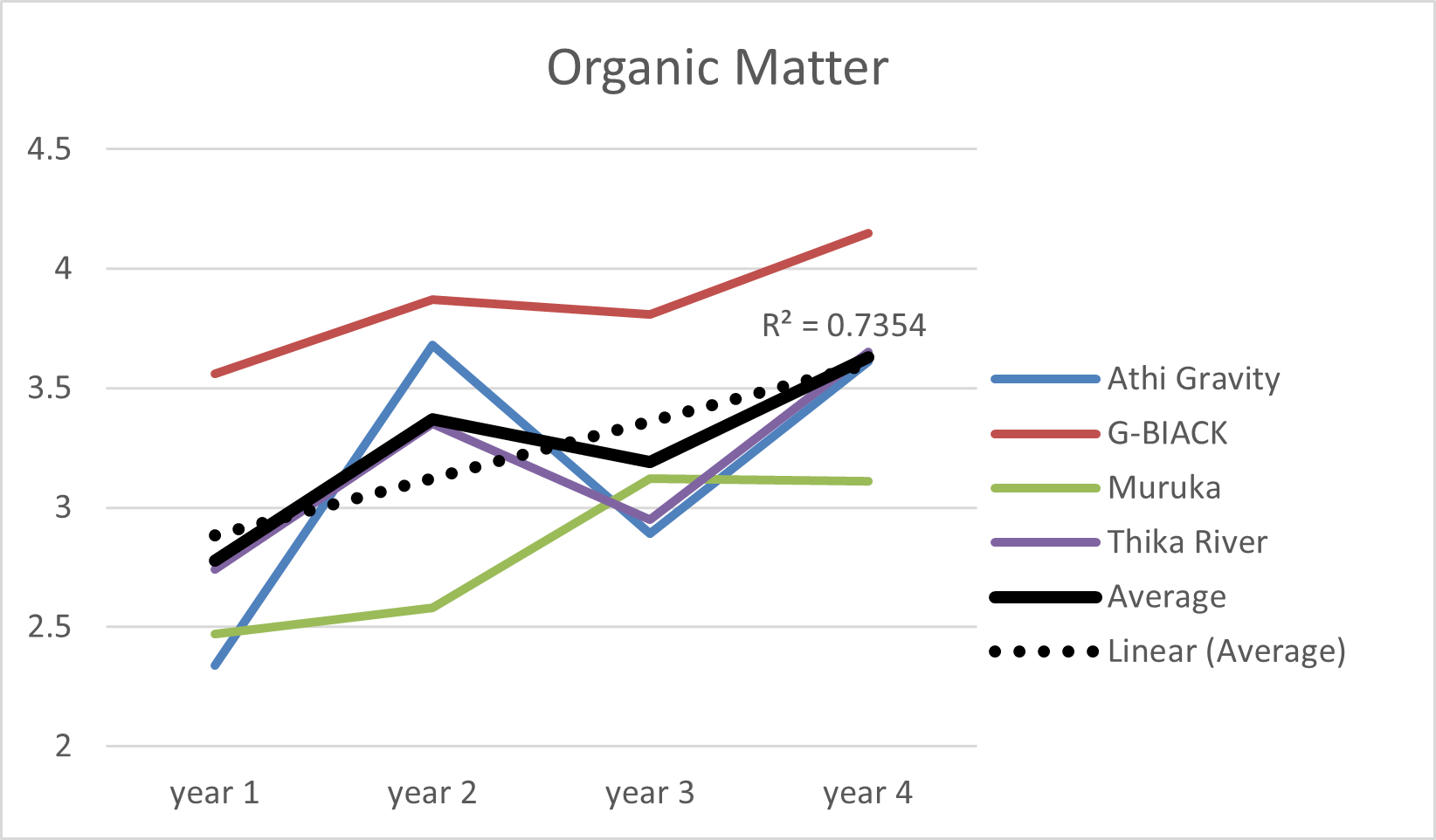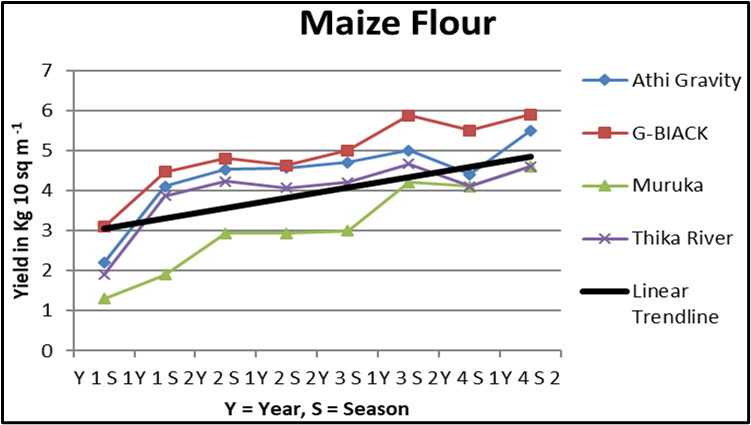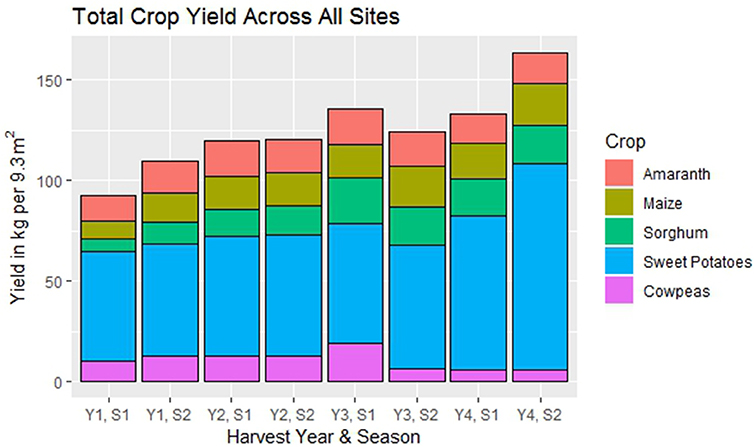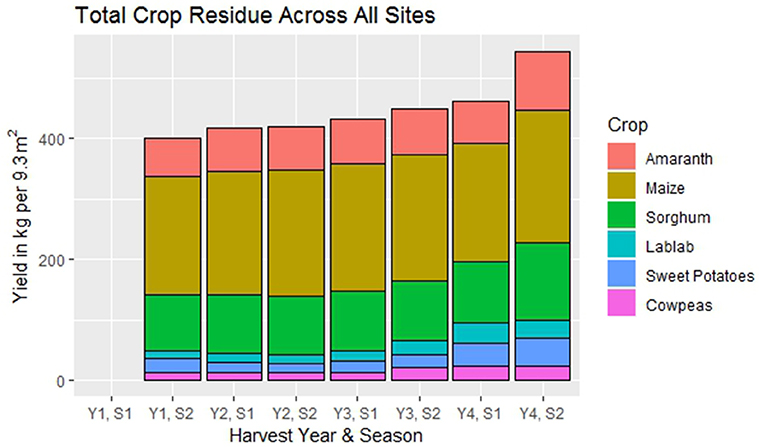Limited Inputs:
GROW BIOINTENSIVE® combined with a single application
of recommended organic fertilizers: Four years of success beyond our wildest dreams
by John Beeby* and Steve Moore**
IMAGE CREDITS: EA staff
GROW BIOINTENSIVE Sustainable Mini-Farming (GB) is a systematized organic food production method comprised of eight well-documented and proven principles: deep soil quality, efficient and effective composting, carbon/compost crop farming, functional biodiversity, seed sovereignty, diet design, planting intensification and whole-farm sustainability (including water, energy and land use). Used together, these principles support increased yields per unit of area and sustainable production over time.
A four-year, four-farm study was undertaken in Kenya to test the idea that GB, combined with a single application of organic fertilizers, could improve soil quality and increase crop productivity without encouraging reliance on yearly fertilizer applications. Ecology Action Soil Test Expert John Beeby developed the concept, designed the research and acquired the needed funding. Samuel Nderitu, co-founder of G-BIACK, was the Kenyan in-country research leader and one of the four farmers. Each farmer double-dug ten new beds (100 sq. ft. each) and grew six crops chosen for cultural appropriateness to Sub-Saharan Africa as well as their ability to provide significant human nutrition and organic matter for compost production per GB requirements. All farm activities were performed by hand with simple tools and no irrigation (natural rainfall only).
Immediately after double-digging, the soil in each of the beds was tested for fourteen soil-quality parameters. Based on the soil test results, fertilizers were recommended and applied to each bed in the first year of the study, to provide missing nutrients and in some cases to adjust pH. The crops were sown using intensive planting on a rotational basis and planted in both annual growing seasons. Harvest weights were recorded for both edible and crop residue (compost material) yields. Crop residues were composted efficiently and returned to the original ten beds, with no additional inputs. Annual soil tests were taken thereafter to monitor changes in soil nutrient levels.
The data was analyzed by Dr. Laura Taylor of Elon University using a three-way fixed effects ANOVA (plants) and ANCOVA (soil) with SAS 9.4. The results were interpreted based on that analysis. Results showed that eight soil parameters increased significantly: boron, electric conductivity, magnesium, organic matter, phosphorous, potassium, sulfur and zinc. There were no significant changes in five parameters: calcium, copper, iron, pH and sodium. Manganese was the single tested element that showed a statistically significant decline. Organic matter (OM) is probably the single best indicator of soil improvement. Figure 1 tracks OM over the course of the study. Data from the four sites was averaged in the solid black line, and the dotted black line indicates a linear trend line. The significant increase in OM indicates a positive feedback loop as efficiently composted crop residues increase OM, which in turn increases crop residues, further increasing OM over time.

Figure 1: Site and year soil organic matter changes with site average (black) and linear trendline (dotted black). Colored lines indicate OM changes at individual sites.
Results for plant data are as follows.
• Crop edible yields increased overall for maize, sorghum and sweet potatoes. Amaranth and cowpea edible yields showed no significant change, and lablab edible yields were inconclusive.
• Crop residue yields increased for cowpeas, lablab, and sweet potatoes. Sorghum residue yields increased marginally and amaranth and maize residue yields showed no significant change.

Figure 2: Maize flour yield over 4 years
Maize is heavily relied on in Sub-Saharan Africa to provide calories for human nutrition so it is significant that maize yields showed a positive response. Figure 2 (above) shows maize edible (flour) yield increase over the four-year study. Total edible and crop residue yields were averaged for the four sites and are shown below in Figures 3 and 4 respectively.

Figure 3: Total crop yield across all sites

Figure 4: Total crop residue yields across all sites
Additionally, it is very interesting to compare the four-year yields of this experiment to the Kenyan average yields for the same years. Individual years varied, but maize yields from the study averaged 83% higher than the country average, sorghum 261% higher, and sweet potatoes 7% lower. No country data (FAO) was available for the other three crops for comparison. Because GB also focusses on diet design and specifically on calorie production, a comparison of the calories indicates a 70% increase in calories per unit of area for the GB system compared to the Kenyan average for the respective four-year period.
It is well-known and documented that the presence of sufficient soil nutrients is essential for increased yields and for human nutrition. It is also known that overapplication of amendments/fertilizers has negative environmental effects. Even average applications of fertilizers are costly and difficult for many of the world’s smallholder farms to acquire year after year. This study shows that a more affordable one-time application of organic fertilizers, combined with the use of GROW BIOINTENSIVE techniques, provides benefits to the farmer for at least four years, making soil improvement more affordable to smallholder farmers. According to the FAO (2012), 1.5 billion smallholder farmers provide food for 2.5 billion people.
Scientific literature supports the individual principles of GB as good organic practices, yet few have applied them in a comprehensive and sustainable system of production like GB does. The data support the ability of GB, combined with a single application of recommended organic fertilizers, to build soil quality and increase both edible and plant residue yields over time, with very few resources needed. Funding support is being actively sought now to expand this work beyond Kenya to include a greater diversity of soils, climates and diet designs.
Read the complete open-source peer-reviewed article Effects of a One-Time Organic Fertilizer Application on Long-Term Crop and Residue Yields, and Soil Quality Measurements Using Biointensive Agriculture (Front. Sustain. Food Syst., 19 June 2020 ) at bit.ly/3hAQgIq.
Thanks to Ecology Action for financial support to make the article open-source and available to everyone everywhere. Also, thanks to Dr. John Doran and his non-profit REAP for encouragement and financial support.
* John Beeby, currently an associate editor and reviewer for Renewable Agriculture and Food Systems, author of Test Your Soil with Plants and Future Fertility, soil consultant for Ecology Action, Treasurer EA Board, founder and consultant of Grow Your Soil (growyoursoil.org), and laboratory manager at Cornell University.
** Steve Moore, former Associate Ex. Dir. Ecology Action (EA), Vice President of EA Board and currently an Intermediate-Level Teacher Certified GB Teacher, author of several peer-review articles on GB Sustainable Agriculture, Professor of Agroecology Elon University (retired) and Permaculture Design Certified.
top | Newsletter Home |Table of Contents| Archive

|






